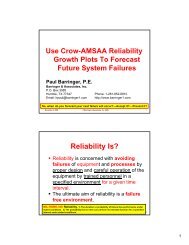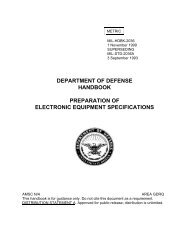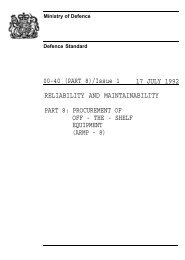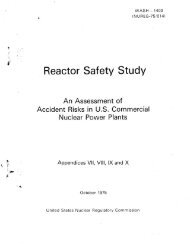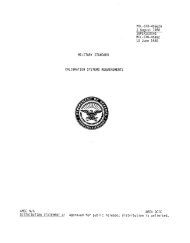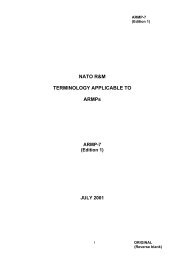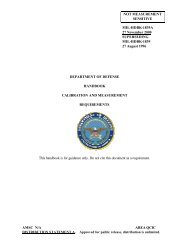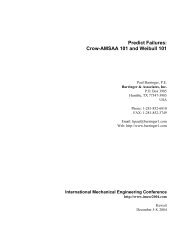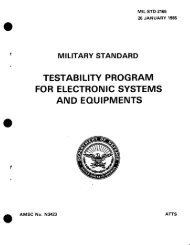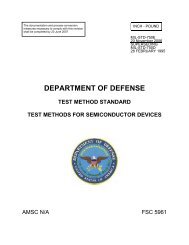MIL-STD-1629-RevA - Barringer and Associates, Inc.
MIL-STD-1629-RevA - Barringer and Associates, Inc.
MIL-STD-1629-RevA - Barringer and Associates, Inc.
Create successful ePaper yourself
Turn your PDF publications into a flip-book with our unique Google optimized e-Paper software.
-.<strong>MIL</strong>-<strong>STD</strong>-<strong>1629</strong>A//:150.1.3 Intended use. The FMECA is potentially one of the mostbeneficial <strong>and</strong> productive tasks in a well structu~d reliability program.Since individual failure modes are lfsted in an orderly, organized fashion <strong>and</strong>evaluated, the FMECA serves to verify desfgn integrity, identify <strong>and</strong> quantifysources of undesirable failure modes, <strong>and</strong> document the reliability risks.FMECA results can be used to provfde the rationale for changes fn operatfngprocedures for ameliorating the effects or for detecting the incipience of theundesirable failure modes. Although the FMECAfs unessential reliabilitytask, it supplements <strong>and</strong> supports other engineering tasks throughidentification of areas in which effort should be concentrated. The FMECAresults are not only used to provide design guidance, but they are usedadvantageously in <strong>and</strong> for maintenance plannfng analys~s, logfstics supportanalysis, survivability <strong>and</strong> vulnerability assessments, safety <strong>and</strong> hazardsanalyses, <strong>and</strong> for fault detectfon <strong>and</strong> isolation design. This coincident useof the FMECA must be considered in FMECA planning <strong>and</strong> every endeavor nade toprevent duplication of effort by the program elements which utilfze FMECAresults.50.2 I%IEA (Task 101). The FMEA is an essential design evaluationprocedure which should not be Iimfted to the phase traditionally thought of asthe design phase. The initial FMEA should be done early fn the conceptualphase when desiqn criteria, missfon requirements, <strong>and</strong> conceptual desiqns arebeing developed”to evaluate the desiaqnapproach <strong>and</strong> to compare the beneffts ofcompeting design configurations. The FMEA will provide quick visibility ofthe more obvious failure modes <strong>and</strong> identffy potential single failure points,some of which can be eliminated with minfmal design effort. As the missfon<strong>and</strong> design definitions become more refined, the FMEA can be exp<strong>and</strong>ed tosuccessively more detafled levels. When changes are made in system design toremove or reduce the impact of the identified failure modes, the FMEA must berepeated for the redesigned portions to ensure that all predictable failuremodes in the new design are considered.50.3 CA (Task 102). The CA fs a procedure for associating failureprobabilities with each failure mode. Since the CA supplements the FMEA <strong>and</strong>is dependent upon information developed in that analysis, it should not beimposed wfthout imposition of the FMEA. The CA is probably most valuable formaintenance <strong>and</strong> logistics support orfented analyses since failure modes whfchhave a high probability of occurrence (high criticality numbers) requirefnvestfgatfon to identify changes whfch will reduce the potential impact onthe maintenance <strong>and</strong> logfstic support requirements for the system. Since thecriticality numbers are established based upon subjective judgments, theyshould only be used as indicators of relative priorities.50.4 FMECA+naintainability information (Task 103). This analysis is anextensfon 0$ h A <strong>and</strong> IS dependent up~ generated fnfonnation;therefore, the ‘~ECA-maintainability information analyses should not befmosed without imposition of the FMEA. The identification of how eachfa!Iurewfll be detected <strong>and</strong> localized will provide information for evaluatingItem testability. The failure mode listing whfch is included on the completedworksheet should be utilized to provide this required data for logistlcssupport analyses (LSA), maintenance plan analysis (MPA), <strong>and</strong> reliabilitycente~d maintenance (RCPI).A-3



